>
Eupercaria/misc (Various families in series Eupercaria) >
Sparidae (Porgies)
Etymology: Rhabdosargus: Greek, rhabdos = stick + Latin, sargus = sargus (1591) (Ref. 45335).
More on author: Valenciennes.
Environment: milieu / climate zone / depth range / distribution range
Ecología
marino; salobre bentopelágico; oceanodromo (Ref. 51243); rango de profundidad ? - 100 m (Ref. 3198). Tropical; 13°S - 36°S
Southeast Atlantic: Angola southward around coast of South Africa to Natal. Reported from Mozambique (Ref. 5213).
Length at first maturity / Tamaño / Peso / Age
Maturity: Lm 23.0, range 22 - 24 cm
Max length : 65.0 cm TL macho / no sexado; (Ref. 3688); common length : 40.0 cm TL macho / no sexado; (Ref. 3688)
Short description
Claves de identificación | Morfología | Morfometría
Espinas dorsales (total) : 11; Radios blandos dorsales (total) : 11 - 13; Espinas anales: 3; Radios blandos anales: 10 - 11. Silvery with distinct crossbars (Ref. 3198).
Found over sandy substrate. Juveniles use estuaries as nurseries (Ref. 27121). Feeds on worms, crustaceans, and mollusks especially mussels (Ref. 5213). Spawns during spring and summer close inshore (Ref. 36731).
Life cycle and mating behavior
Madurez | Reproducción | Puesta | Huevos | Fecundidad | Larva
Conflicting descriptions of the reproductive style of this species have been reported, e.g., Ref. 4359 describe this species as being a gonochorist (Ref. 28504). Also Ref. 103751.
Bauchot, M.-L. and J.-C. Hureau, 1990. Sparidae. p. 790-812. In J.C. Quero, J.C. Hureau, C. Karrer, A. Post and L. Saldanha (eds.) Check-list of the fishes of the eastern tropical Atlantic (CLOFETA). JNICT, Lisbon; SEI, Paris; and UNESCO, Paris. Vol. 2. (Ref. 3688)
IUCN Red List Status (Ref. 130435: Version 2024-1)
Threat to humans
Harmless
Human uses
Pesquerías: escaso valor comercial; pesca deportiva: si
Herramientas
Special reports
Download XML
Fuentes de Internet
Estimates based on models
Preferred temperature (Ref.
123201): 14.5 - 26.4, mean 23.8 °C (based on 102 cells).
Phylogenetic diversity index (Ref.
82804): PD
50 = 0.5156 [Uniqueness, from 0.5 = low to 2.0 = high].
Bayesian length-weight: a=0.01259 (0.00609 - 0.02604), b=3.03 (2.86 - 3.20), in cm total length, based on LWR estimates for this (Sub)family-body shape (Ref.
93245).
Nivel trófico (Ref.
69278): 3.0 ±0.2 se; based on diet studies.
Generation time: 6.9 ( na - na) years. Estimated as median ln(3)/K based on 1
growth studies.
Resiliencia (Ref.
120179): Medio, población duplicada en un tiempo mínimo de 1.4-4.4 años (K=0.16).
Fishing Vulnerability (Ref.
59153): Moderate to high vulnerability (54 of 100).
Climate Vulnerability (Ref.
125649): Moderate to high vulnerability (48 of 100).
Nutrients (Ref.
124155): Calcium = 72.5 [39.7, 137.6] mg/100g; Iron = 0.8 [0.4, 1.5] mg/100g; Protein = 18.4 [17.3, 19.5] %; Omega3 = 0.232 [0.139, 0.391] g/100g; Selenium = 65.5 [32.2, 121.5] μg/100g; VitaminA = 22.4 [7.0, 57.1] μg/100g; Zinc = 1.46 [1.01, 2.07] mg/100g (wet weight);
